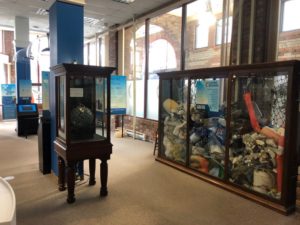The Great Pacific Garbage Patch is exactly what it sounds like it is: 80,000 tonnes of our shit floating in the ocean. Broken down, that’s the weight of roughly 500 jumbo jets, or about 250 pieces of garbage for every human being walking this planet.
The Maritime Museum of BC’s exhibit The Great Pacific Garbage Patch aims to convey the realities behind the patch and what we can do to stop the patch from getting worse.
“It’s not something that just kind of hangs out in our oceans and we can forget about it; this actually affects us on a very personal basis as humans,” says Maritime Museum of BC associate director Brittany Vis. “It affects our health in different ways, as well as our economy… Plastic is what simply doesn’t degrade.”

The exhibit starts by explaining what the Great Pacific Garbage Patch is: a mass of debris in a distinctive area, says Vis, who describes it as more of a smog than a patch. The exhibit explores the impacts on wildlife and humans. (It’s also timely, with World Oceans Week having recently taken place from June 1 to June 8.)
“Plastics are out in the oceans. They’re getting broken down into smaller pieces—so they end up being microplastics,” says Vis. “Animals end up eating these plastics. And, of course, we fish.”
This means that we ingest a lot of these chemicals, says Vis.
“Our health is majorly impacted, and of course it’s just going to get worse and worse to the point where we might not even be able to eat any fish,” says Vis.
But despite all the focus on doom and gloom, Vis says that the exhibit actually ends on a more positive note.
“We explore work that different organizations around the world are doing,” she says, adding that in BC and Canada there’s a big focus on initiatives like shoreline-trash clean-ups.
Over time, the little habits count, too: for example, using reusable shopping bags can create much-needed environmental change. Vis says that no one knows what will happen if we keep going down the path we’re on.
“The fact that we don’t really know is kind of scary in and of itself,” she says. “Hopefully we don’t get to that point.”
But it’s a timely subject matter, which is part of the reason the museum decided to put the exhibit together, says Vis.
“We spend a lot of time researching and exploring with the public our history and our interactions with the oceans in many different ways,” she says.
Vis says this is a prominent topic, considering how humans have been treating oceans for the last hundred years.
“It’s quite mind-boggling,” says Vis about the short period of time that it has taken us to do so much. “That was one thing when I started doing the research that just hit me: ‘Wow, these are such massive numbers that we’re looking at right now,’ and it’s just absolutely overwhelming at first.”
So Vis started breaking the situation down, asking herself what she could do as an individual, and what the museum could do as an organization.
“You just hope to inspire change from there,” she says.
The Great Pacific Garbage Patch
Until Sunday, October 27
$8 student rate, Maritime Museum of BC
mmbc.bc.ca
